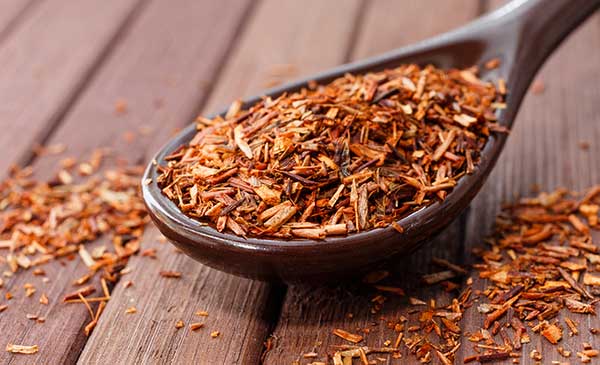A Guide to the Benefits of Rooibos Tea

Rooibos may seem like a newcomer to the tea party when compared to tea from the 1000-year-old Camellia sinensis plant, but rooibos has been around for over 300 years. Native to South Africa, rooibos is also known as Red Bush Tea or African Red Tea.
Rooibos is a plant indigenous to a region just north of Cape Town. This red bush plant thrives in this dry, mountainous region that receives periods of heavy rainfall. When harvested and processed rooibos steeps to a reddish-brown herbal tea.
When the Dutch settled in South Africa in the 1700s, they discovered this red bush in search of an alternative to the expensive imported black tea of the time. However, it didn't become commercialized as a tea crop for another 200 years. Since then rooibos has continued to emerge as a popular herbal infusion with a less oxidized green rooibos variety being created as recently as the 1990s. Presently rooibos has expanded into recipes, extracts, and even cosmetics!
Rooibos can be found in delicious blends ranging from smoky, sweet, woody, grassy, vanilla, fruity, honey, herbal, and caramel flavors that really don't need anything added. However, it is a tradition in South Africa to add a splash of milk and a bit of sugar or honey when drinking rooibos tea. As an herb, rooibos steeps into a cup of tea that is naturally caffeine-free to be enjoyed anytime of day.

A South African Gem
South Africa is still the only country in the world producing rooibos. Local Cape Town farmers continue to harvest wild rooibos, while commercially, rooibos is now grown in other regions of South Africa. With over 450 growers combined, South Africa creates an annual production of 15,000 tons of rooibos. A little under half of that is exported to countries around the world, with the United States being one of the five largest importers.
The early spring bloom of the rooibos plant produces a single seed inside each yellow flower. Ejected by the legume of the flower, the seeds drop to the base of the plant. Sifting through the soil around the plant, farmers gather seeds for the next spring crop.
While the Camellia sinensis plant takes nearly two years to mature enough for harvesting and five years before the plant is really a tea leaf producer, rooibos goes from seedling to harvest in about 1.5 years with harvest typically occurring during the summer months.

The Rooibos Process
While we have discussed a few differences between rooibos and the Camellia sinensis plant, the two are actually harvested with similar methods.
The stems and leaves are hand-picked and tied into bundles. The bundles are then allowed to oxidize as with tea plants. Exposure to oxygen releases the essential oils from the plant, developing the color and flavor that will soon become tea.
The longer the oxidation process occurs, the richer the color and sweeter the flavor of red rooibos. On the other hand, green rooibos is steamed and immediately dried instead of allowing it to go through the oxidizing process giving it more of a grassy flavor.
Just as with tea from the Camellia sinensis plant, the grade of rooibos is determined by the ratio of leaves to stems. More leaves and fewer stems are considered to be a higher, more flavorful grade of rooibos.
What are the Benefits of Rooibos Tea?
Beneficial for skin
Rooibos tea contains alpha hydroxy acid and other enzymes commonly used for skin treatments and may help to reduce wrinkles. Rooibos has a high vitamin C content which is known to help repair collagen. By helping reduce irritation and redness, Rooibos tea may also result in more even-toned skin. If you suffer from eczema or acne, the zinc content in rooibos may provide some relief (1).
The antioxidants in rooibos may also help fight free radicals which are known to speed up the aging process. While research is still ongoing, some studies are showing that drinking a few cups of rooibos tea per day can keep skin looking even and youthful.
Pain relief
Inflammation is the common cause of painful arthritic symptoms. The anti-inflammatory properties of the antioxidants found in rooibos tea may help to reduce common aches and pains. The high vitamin C content in rooibos is known to help repair connective tissue in joints.
Allergy relief
Rooibos should not replace inhalers and other corticosteroids, but the flavonoids contained in rooibos may help prevent and relieve allergy symptoms in a natural way without the drowsiness that can occur with allergy medications. It can act as a bronchodilator, relieving allergy symptoms such as the feeling of wheezing and coughing (2). The flavonoids also block cells from releasing histamines that trigger the allergic reaction in the first place (3).
Support bone health
Strong bones need key minerals such as calcium, manganese, and fluoride which are found in rooibos. Many true teas and tisanes also contain these minerals, however, rooibos also contains flavonoids (luteolin and orientin) which have been studied for their potential to increase mineral content in bones even further. (4)
Digestive aid
Doesn't it seem like we're hearing more and more often about people suffering from digestive problems from chronic problems to Celiac disease? Often it seems to point back to a poor diet consisting of too many processed foods. Studies are providing increased support for the potential benefit of drinking tea to help with digestive issues.
Antispasmodic nutrients in rooibos tea may help prevent stomach pain. Studies have shown the flavonoids in rooibos (quercetin, orientin, and vitexin) may help to relax the digestive system and relieve stomach pain and discomfort, as well as possible relief from diarrhea due to the tannin content (5).
Diabetes control
Studies have shown that the polyphenols in rooibos tea may help regulate blood sugar levels, increase glucose tolerance, and decrease insulin resistance preventing the onset of Type 2 Diabetes. Symptoms were shown to improve with regular consumption of rooibos tea (6).
Heart health
The same flavonoid that acts as a bronchodilator is also helpful in lowering blood pressure and improving circulation. Rooibos provides a relaxing effect that helps open up blood vessels. This allows the antioxidants an opportunity to work on reducing the risk of heart disease by lowering bad cholesterol and prevent the buildup of plaque to help keep blood circulating smoothly (7).
For a deeper diver into the benefits of Green Rooibos, click here.

How to Brew Rooibos
- As with all loose leaf tea, start with pure, cold filtered water.
- We recommend steeping 1.5 tsp per 8oz at 208° for 5-6 minutes.
- With any loose leaf tea, you want to be sure to keep the heat in by covering your infuser while the tea steeps.
- If you prefer a stronger cup of rooibos, go ahead and experiment. Rooibos is more forgiving than black or green teas and it won’t become too astringent and bitter if infused longer; the infusion will just get stronger and more flavorful.
- If you don’t have a temperature-controlled electric kettle, just remember that at sea level your water will reach a simmer at 190 degrees and boils at 212 degrees. Subtract a degree for every 100 feet in altitude increase.
- Good quality loose leaf rooibos can typically be infused a couple of times, and can also be enjoyed as an iced tea!
How to Store Rooibos
When it comes to tea storage, rooibos is no different than your other teas. Be sure to keep it in an airtight container, away from heat, moisture, and fragrant items such as coffee or spices and you can enjoy it for up to two years. It won’t ever really go “bad” but it can get stale creating a weak or musty flavor.
Sources:
(1) https://www.ncbi.nlm.nih.gov/pubmed/20412217
(2) https://link.springer.com/article/10.1007/s00394-006-0620-0#page-1
(3) https://www.drweil.com/vitamins-supplements-herbs/herbs/quercetin/
(4) https://www.ncbi.nlm.nih.gov/pubmed/25488131
(5) https://www.ncbi.nlm.nih.gov/pubmed/23238530
(6) https://www.ncbi.nlm.nih.gov/pubmed/23238530
(7) https://www.ncbi.nlm.nih.gov/pubmed/25338943





